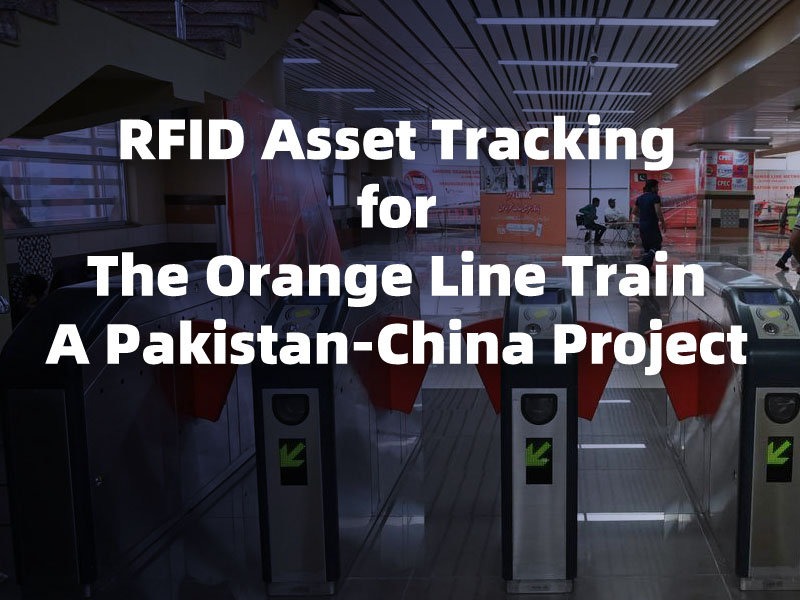Your location: Home Page > RFID Blog | SILION TECH > RFID Asset Tracking for the Orange Line Train: A Pakistan-China Project
News and Information
RFID Asset Tracking for the Orange Line Train: A Pakistan-China Project
Author:2024-06-06 16:20:48
The Orange Line Metro Train project, a monumental collaboration between Pakistan and China, represents a significant leap forward in urban transportation for Lahore. As the first metro train in Pakistan, the Orange Line is set to revolutionize public transit and ease the traffic woes of Lahore's burgeoning population. One of the key technologies enabling the efficient operation and maintenance of this project is RFID asset tracking.

The Orange Line Metro Train Project
Inaugurated in 2020, the Orange Line Metro Train spans 27.1 kilometers, connecting Raiwind, Multan Road, McLeod Road, and the Grand Trunk Road. This line comprises 26 stations, 24 elevated and 2 underground, and was built with a significant investment from China under the China-Pakistan Economic Corridor (CPEC) initiative. The project aims to provide a modern, reliable, and efficient means of transportation to over 250,000 passengers daily.
The Need for Advanced Asset Tracking
Managing a project of this magnitude requires meticulous coordination and management of numerous assets, from train carriages to track maintenance equipment and station facilities. Traditional asset management methods are often prone to errors, inefficiencies, and delays, which can disrupt operations and increase costs.
RFID asset tracking emerges as a crucial technology in addressing these challenges. By using RFID tags and readers, asset tracking becomes automated, providing real-time data on the location, status, and condition of assets. This technology ensures that all assets are accounted for, well-maintained, and optimally utilized, significantly enhancing the efficiency and reliability of the Orange Line Metro Train operations.
How RFID Asset Tracking Works
RFID asset tracking involves attaching RFID tags to various assets. These tags contain microchips that store information about the asset, which can be read by RFID readers. The readers, installed at strategic points along the metro line and stations, continuously scan for these tags, updating the asset's location and status in real-time.
The data collected by the RFID system is then transmitted to a central database, where it can be analyzed and used for various purposes, including inventory management, maintenance scheduling, and operational planning. This real-time visibility into asset status allows for proactive management and swift resolution of any issues that may arise.
Benefits of RFID Asset Tracking for the Orange Line
1. Enhanced Operational Efficiency
RFID asset tracking streamlines the management of assets by providing precise and up-to-date information. This reduces the time spent searching for equipment and ensures that all assets are in the right place at the right time, enhancing the overall efficiency of the metro operations.
2. Improved Maintenance Management
Regular maintenance is crucial for the safe and reliable operation of the metro train. RFID technology enables predictive maintenance by monitoring the condition and usage patterns of assets. Maintenance activities can be scheduled proactively, reducing downtime and extending the lifespan of critical assets.
3. Reduced Operational Costs
By automating asset tracking and management, RFID technology reduces the need for manual inspections and inventory checks. This not only cuts labor costs but also minimizes errors and inefficiencies, leading to substantial cost savings over time.
4. Enhanced Security and Theft Prevention
RFID tags can help in tracking high-value assets, reducing the risk of theft or misplacement. If an asset is moved without authorization, the RFID system can immediately alert the management, allowing for quick action to prevent loss.
5. Better Resource Allocation
Real-time data provided by RFID technology helps in better resource allocation. For instance, if a particular station is experiencing high traffic, additional resources can be allocated promptly. This ensures a balanced distribution of assets and smooth operations across the entire metro line.
Case Studies and Real-World Applications
RFID asset tracking has been successfully implemented in various metro systems worldwide, showcasing its effectiveness and reliability. For example, the New York City Subway and the London Underground have integrated RFID technology for asset tracking and maintenance management, leading to improved service reliability and customer satisfaction.
In China, the Beijing Metro uses RFID for train and track maintenance, significantly reducing operational disruptions and enhancing safety standards. These real-world applications provide a strong validation for the implementation of RFID technology in the Orange Line Metro Train project.
The integration of RFID asset tracking in the Orange Line Metro Train project is a significant step towards modernizing Pakistan’s urban transit infrastructure. This technology not only enhances operational efficiency and reduces costs but also ensures the safety and reliability of the metro services. As Lahore continues to grow, the Orange Line, supported by advanced RFID technology, will play a pivotal role in providing a sustainable and efficient transportation solution.
SILION TECH, as a leading RFID supplier and solution provider, is proud to contribute to such transformative projects. Our cutting-edge RFID solutions are designed to meet the unique challenges of large-scale infrastructure projects, ensuring seamless operations and superior asset management. For more information on how our RFID technology can benefit your projects, contact SILION TECH today.